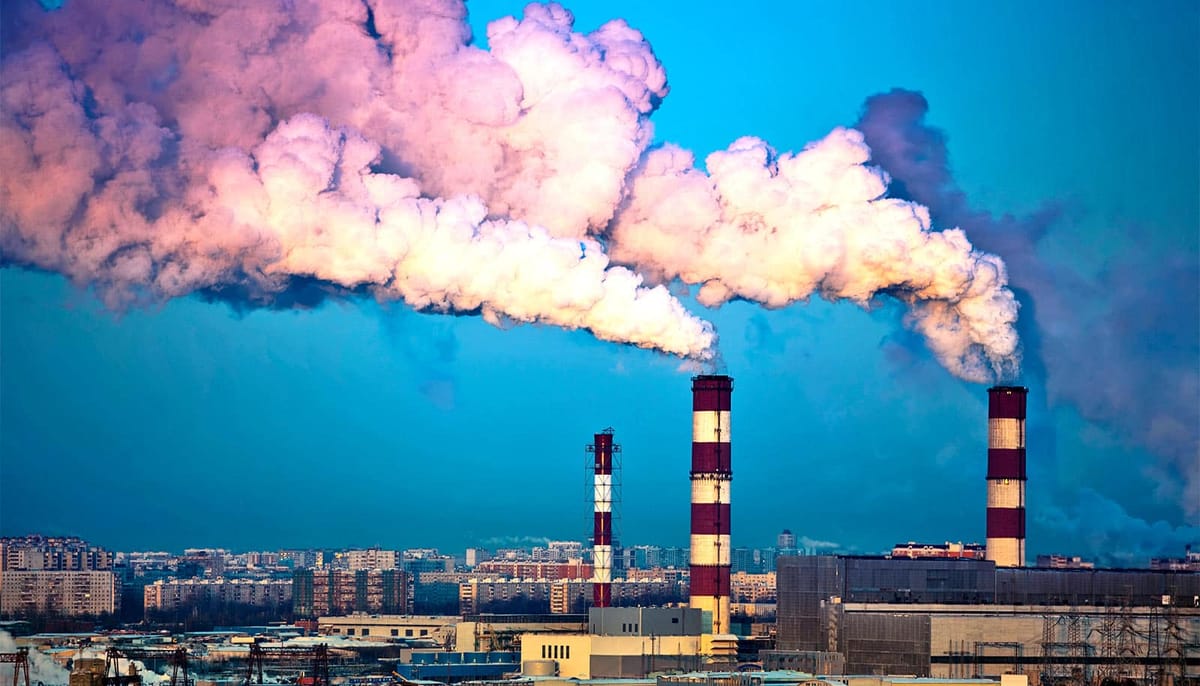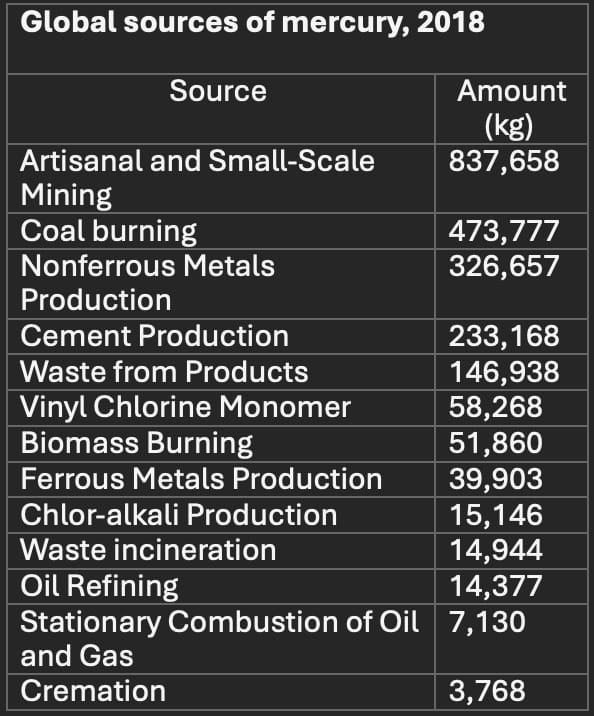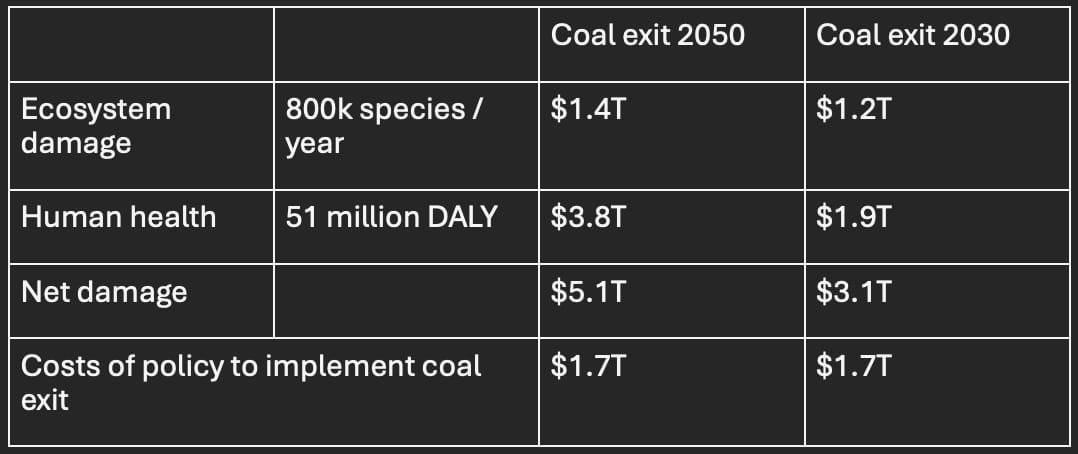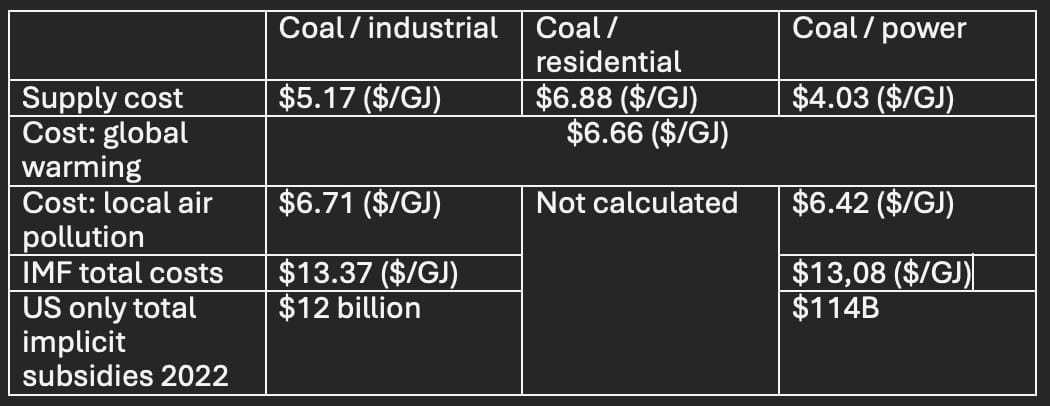Coal Industry Deep Dive Part 3: The Non-Climate Costs

We’ve shown that the external harms of coal specifically associated with climate damage greatly exceed the gross revenues of the worldwide industry. Now, we turn to the less-heralded, non-climate costs. We show here that these costs also exceed the industry’s revenues. To reiterate: The coal industry’s external harms are so vast compared to its revenues that both the climate-related external harms and the non-climate harms each exceed the global revenues of the industry.
It’s often lost in the discussion of the urgent need to exit fossil fuels but all of them - coal, oil, methane – create vast other environmental and human health costs during extraction, transport, refining, distribution and combustion. Coal is simply the worst. Coal mining emerged many centuries ago, and fueled the industrial revolution: coal-fired engines were the backbone of industrial growth from the late 18th century until well into the 20th century. Similarly, coal fireplaces and furnaces were how homes and then offices were warmed, and how iron and other metals were smelted. In consequence, the world’s coal-mining districts have long histories that entwine the extraction of coal and local economies in a fabric that predates modern safety and environmental considerations.
In this piece we look at several categories of harms, but by no means all. Then we move to tallying these costs, largely using estimates from others.
Human Health Consequences from Burning Coal
For many years, travelers described London as having dense, pea-soup fogs. These, and the eerie sunsets they caused, are depicted in paintings by Turner, Monet and others. These are now gone. From the 1700s to well into the 1970s, coal was the dominant fuel: for homes, using coal delivered up and down residential streets and burnt in fireplaces in homes; for industry, using coal to heat steam in boilers; and for electrical power, coming from vast, coal-fired, riverside powerplants – including Battersea (seen in a Pink Floyd album cover) and Bankside (now the Tate Modern gallery). Their sooty exhausts were sometimes caught in damp air, with a high-pressure atmospheric system pressing them down into the Thames River valley. Then, ghastly smogs: the particles in the soot forming the nuclei for a cold, hideous, killing fog. The worst of these, in 1952, killed at least 4,000 people. The last coal-burning power plants in Britain shut down in late September, 2024 becoming the first major nation to turn its back on coal for power, just as it was the first to adopt it. Really.

- The health costs continue today: “Coal-fired power plants are the nation’s largest industrial polluter. The air pollutants from power plants—CO2, sulfur dioxide, nitrogen oxides, small particles, mercury, and other air toxics harm public health, causing unhealthy levels of ozone smog and fine particulate pollution that damages lungs and can shave years off people’s lives.” One major element in this is fine-grained particles that damage lung function. “For every 1 μg/m3 increase in coal PM2.5, mortality increased by 1.12%. This is more than twice the risk that was previously associated with general PM2.5 exposure from all air pollution sources. … between 1999 and 2020, 460,000 deaths would not have occurred in the absence of emission from the coal power plants. From 2000 to 2008, deaths associated with coal PM2.5 were 25% of all PM2.5-related deaths in the Medicare population. From 2013 to 2016, coal PM2.5 deaths were only 7% of all PM2.5-related deaths (as use of coal declined)."
Mercury
The role coal-burning plants play in creating mercury-poisoned land and waters downwind from coal-burning power plants is well established. Mercury is a highly toxic heavy metal that poses severe health risks to humans and ecosystems, primarily due to its neurotoxic effects. These consequences are of particular significance in developing countries, as well as those in transition to higher-wealth status. In the United States alone, over 300,000 infants are born each year with mercury levels posing significant risks for neurological and developmental issues.
Combustion of coal contributes approximately 21% of global mercury emissions. The following table illustrates that coal-burning is the second-largest source of Mercury emissions worldwide.

A comprehensive assessment estimates that the health-related costs of mercury pollution could amount to around $19 trillion globally between 2010 and 2050 – which implies that coal’s burden of this across that 40-year span could be as high as $4 trillion, thus $100 billion per year. (This high cost burden will likely endure long after coal’s disappearance: mercury does not easily clear from the human body.)
The Human Costs of Mining Coal
The activity of working underground, in coal mines, exposed large quantities of workers to the risks of mine collapses and explosions. The latter mostly are caused by sparks or lamps igniting coaldamp – methane reserves held within coal seams. These become vast explosions when they ignite fine coal dust. The largest single coal mining disasters each killed over 1,000 workers; many have killed hundreds.
And for workers whose lives were not taken by sudden catastrophes in the mines, there was the risk of black lung: a disease in which coal dust settles in the lungs where it can not be destroyed or removed by the human body’s natural processes. As recently as 2013, the worldwide death toll from black lung disease was 25,000 per year. Again, this cost will continue long after the last coal mine closes.
Other natural destruction from coal mining
In October 1966, the Welsh coal-mining village of Aberfan had heavy rains. These rains soaked into a vast pile of tailings – the spoils from the nearby – turning much of it into a hideous slurry. This collapsed onto the village, burying and killing 116 children in a school which was buried in the collapse, plus 28 adults, many of whom were teachers.
Are we done? We conclude here, although we have not at all exhausted the categories of coal’s external harms, for the list goes on and on and on. For example: Coal mining creates large amounts of spoils, tailings: debris that slips or washes – or sometimes is deliberately dumped – into rivers and watersheds, killing fish and putting poisons into drinking water sources. And its transport causes inordinate costs because coal is heavy (the best coal provides about 29MJ – million Joules of energy per kg, whereas easier-to-transport oil is 44 – 46 MJ / kg, and natural gas ranges from 42 to 55 MJ/kg). So, the ships that transport coal from Australia to China burn more diesel than they would if they were transporting other fossil fuels. Despite this inefficiency, coal was at least 11% of all global cargo shipping by weight in 2018. And there’s habitat damage. And then there’s bribery and corruption to keep a destructive industry going and its harms hidden. And the list goes on, but we rest.
Non-Climate Harms Quantified
So grave are the harms from coal - even beside the climate harms - a 2020 analysis from researchers at the University of Potsdam, Germany, concluded that even when only accounting for domestic environmental effects, the benefits of phasing out coal outweigh the economic costs. Coal phaseout should be considered as a “no-regret” policy option. Indeed, the title of this report Coal-exit health and environmental damage reductions outweigh economic impacts illustrates our general thesis: that coal’s external harms are so great that eliminating its use would create large benefits - considered as economics, but expressed as human health and a more vibrant ecosystem. Its mathematical analysis at summary level differs from ours in at least one important respect: specifically, that it aims to value the economic benefits of ceasing coal use, whereas we aim to calculate the economic harms of - in this instance - continued coal use (We assume that the continued harms are equivalent to the estimated benefits - net of the policy costs of terminating coal use - but acknowledge that this is a big assumption. For this reason, and because we wanted to align our analyses with theirs, we have tried to correspond with Prof. Rauner but without success, so far.).
Factors included in the Potsdam analysis are: land use; freshwater toxicity and eutrophication; human toxicity; marine damage; ozone depletion; air pollution; petrochemical oxidants; ground acidification; toxification of ground; land transformation; water depletion. These are aggregated into natural ecosystem damage and human health. Offsetting these are considerations of policy costs. The following table summarizes this analysis, considering the benefits from coal exit calculated to be costs if not implemented.

Nor is this analysis the only one that indicates that coal’s prices do not come close to covering the true social cost. The IMF’s analysis of implicit subsidies of fossil fuels provides the following analysis. Note, this states both costs and revenues in USD$/gigajoule of energy (this to allow comparison across different fuel types). No analysis is provided for local air pollution costs associated with residential fuel use, nor is it evident that mercury, riverine, habitat destruction or other costs are included.

The following table, also using data from the IMF model, summarizes total implicit subsidies for coal by global region

So, again, when we use the IMF’s estimate that local air pollution costs and global warming each account for about one half of the calculated external costs – implicit subsidies – we again see the worldwide coal industry with climate and non-climate costs significantly higher than the industry sector’s gross revenues. But it seems modest in scope if the IMF estimates of coal’s harms are $2B/year, with one half from “local pollution”. How do we square this with the extensive reduction in life from coal burning and the specific estimate of $100B/year just from mercury emissions?
Similarly, even against a background of enduring environmental and human health consequences, has coal enriched the areas where coal is mined? What has life been like for coal-mining communities? Researchers from the University of West Virginia – a key geography for Appalachian coal-mining – and the University of Washington (far, far away!) in 2009 published an analysis of elevated mortality in Appalachian coal-mining areas for the period 1970 to 2005. The methodology was rigorous, comparing outcomes in high-mining, low-mining and non-mining regions of Appalachia, and other counties in the USA. Let’s acknowledge the obvious: the study period ended nearly 20 years ago, before many technical, economic, societal and other changes, and coal-mining in that region may not be broadly representative of other coal-mining regions.
Key findings:
- Excess annual deaths in coal mining areas ranged from 1,736 to 2,889. (This is after adjusting for covariates. Before such adjustments, the annual excess deaths in Appalachian coal-mining counties ranged from about 4,000 to nearly 11,000.)
- Appalachian coal mining areas had 77 excess deaths per 100,000 head of population versus the rest of the nation (1979–1983); this rose to 126 excess deaths per 100,000 during the last five years (2001–2005).
- The study estimates that costs associated with the values of lives lost exceeded the economic benefits of coal mining to the region by approximately $41.8 billion over the course of the 25 years covered by the analysis.
The authors note that their “cost estimates may be conservative because they do not consider reduced employment productivity resulting from medical illness, increased public expenditures for programs such as food stamps and Medicaid, reduced property values associated with mining activities, and the costs of natural resource destruction.” Nor do the authors consider downstream damage, such as from pollution from transporting or burning coal.
Summary
- As noted in the first in this series: the global coal industry ships about 8.3 billion tonnes per year, generating gross revenues of about $800 billion.
- The IMF’s 2023 model of implicit subsidies estimate the local pollution (non-climate) costs of burning coal to be in excess of $1 trillion per year: thus at least 30% greater than the industry’s gross revenues.
- The more comprehensive review of non-climate harms from the University of Potsdam estimates the non-climate harms to be as high as $3.1 trillion.
- We have found multiple indications that suggest that the IMF estimate would be low, simply on the basis of apparently excluded categories of harm. We have found no reports – and we’ve looked – that suggest coal’s non-climate harms to be less than the gross revenue of the sector.
Even without the terrifying consequences of climate damage, the coal industry is sustained only on the basis of tolerance of astonishing levels of damage: to human health and to the natural environment.
It’s stunning and it must end.
Comments ()